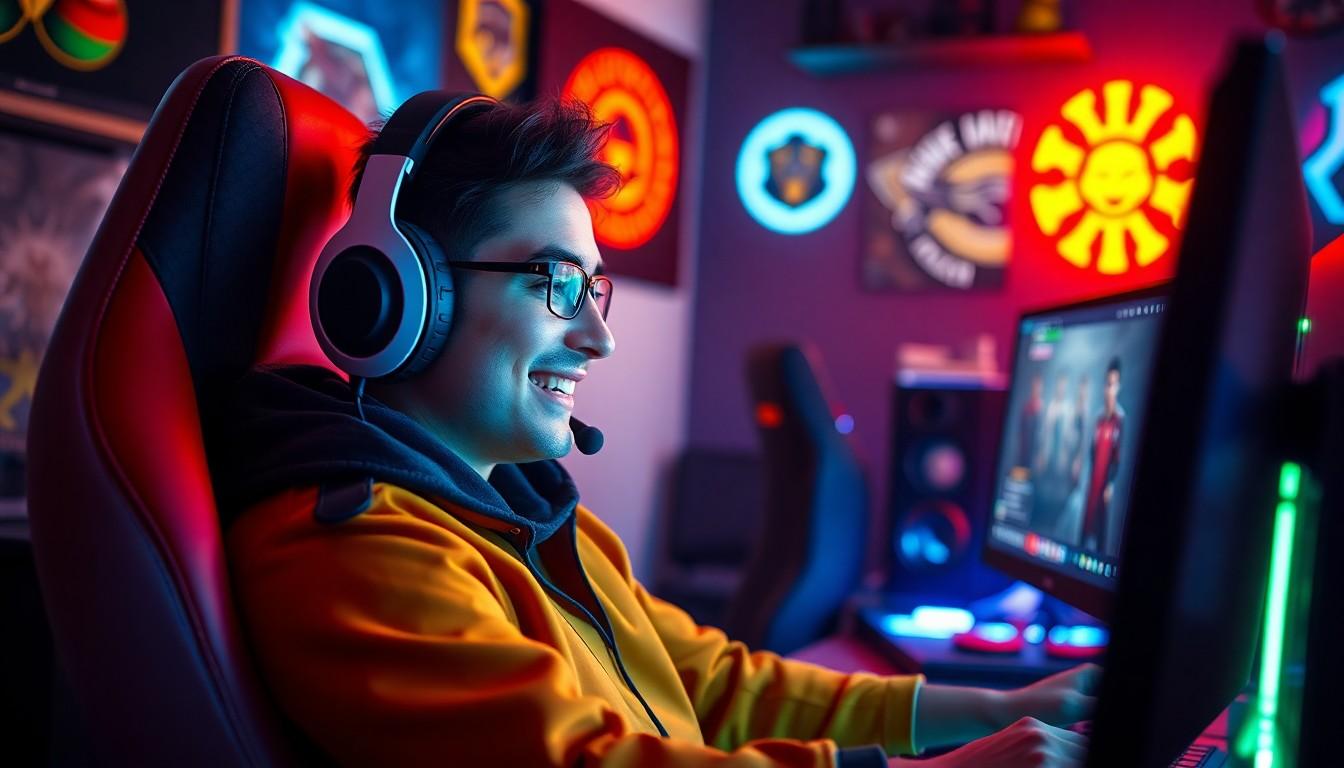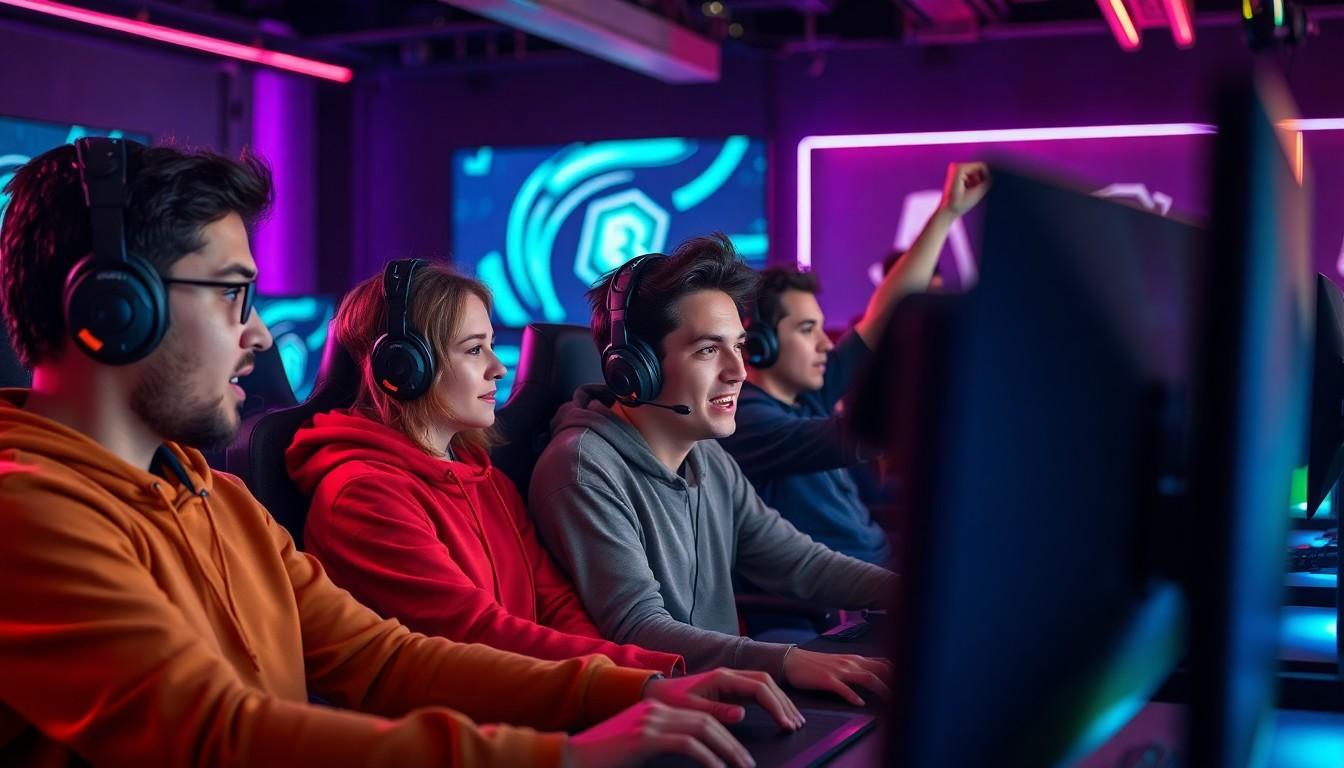Competitive Gaming Content: Why It’s the Future of Entertainment and Community Building

In a world where gaming isn’t just a pastime but a full-blown spectacle, competitive gaming content has taken center stage. Picture this: players battling it out in virtual arenas, their skills on the line, and millions of fans cheering them on from the sidelines. It’s not just about winning; it’s about creating unforgettable moments that keep audiences glued to their screens.
From epic plays to jaw-dropping fails, competitive gaming content offers a rollercoaster of emotions. It’s like watching a soap opera, but instead of dramatic love triangles, there are insane headshots and clutch plays. Whether you’re a hardcore gamer or just someone who enjoys a good laugh, this content has something for everyone. Dive into the thrilling world where strategy meets entertainment, and discover why competitive gaming is the new frontier of digital storytelling.
Competitive Gaming Content
Competitive gaming serves as a dynamic platform where players demonstrate exceptional skills in various video games. Millions of viewers engage with this content, transforming what was once a niche hobby into a global phenomenon. Tournaments feature intense matchups, showcasing strategies and techniques that captivate fans, both novice and expert.
Content within this genre ranges from live streams of major competitions to highlight reels that distill epic moments into digestible formats. Players create unique narratives around their experiences, enhancing the storytelling aspect of competitive gaming. Audiences connect emotionally with players, often rooting for specific teams or individuals during high-stakes matches.
Platforms such as Twitch and YouTube play a pivotal role in the dissemination of competitive gaming content. These platforms host live events, interact with viewers in real-time, and allow creators to build communities surrounding their favorite games. Content creators often share analysis and commentary, deepening the audience’s understanding of gameplay mechanics or team strategies.
Esports organizations leverage competitive gaming content for branding opportunities to attract sponsors and partnerships. Marketing campaigns frequently focus on engaging fans through merchandise and exclusive content, reinforcing loyalty within the community. Competitive gaming stands at the forefront of digital entertainment, merging skill, strategy, and storytelling into a captivating experience for millions globally.
Types of Competitive Gaming Content

Competitive gaming content encompasses several formats that engage and entertain audiences. Fans enjoy watching various types of content that highlight player abilities and strategies.
Live Streaming Platforms
Live streaming platforms play a crucial role in competitive gaming. Twitch and YouTube Gaming dominate this space, offering real-time interactions between players and viewers. Players showcase their skills through live tournaments and casual streams. Viewers engage by chatting, reacting, and supporting their favorite gamers. This interactive experience allows fans to witness the action as it unfolds, fostering a sense of community. Streamers often provide commentary, analysis, and personal insights, enhancing the viewing experience and promoting deeper connections with their audiences.
Video On-Demand Content
Video on-demand content serves as an essential component of competitive gaming. Creators upload highlight reels, tutorials, and match analyses on platforms like YouTube. These videos condense intense moments into manageable segments, making it easier for viewers to catch up on what they missed. Tutorials help aspiring gamers improve their skills by offering strategies and techniques applicable to various titles. Match analyses provide in-depth examinations of gameplay mechanics, enabling fans to understand the intricacies of their favorite competitions. Together, these formats ensure a wealth of content for audiences, whether they’re casual viewers or dedicated fans.
Importance of Competitive Gaming Content
Competitive gaming content serves as a cornerstone in the entertainment industry, driving viewership and participation worldwide. The diverse formats engage audiences and build solid connections within the gaming community.
Audience Engagement
High levels of audience engagement characterize competitive gaming content. Viewers relate emotionally to the intense rivalries and thrilling matchups that unfold during tournaments. Content creators use interactive elements, such as chat features on platforms, to encourage real-time conversations. Fans often participate in live streams by sharing their thoughts and cheering for their favorite players or teams. This interactivity enhances the viewing experience, making participants feel like part of the action. Players respond directly to their audiences, fostering a deeper connection that transcends passive watching. Additionally, highlights and play analysis enrich viewers’ understanding and appreciation of the competitive landscape.
Community Building
Community building thrives within competitive gaming content. Gamers and fans come together around shared interests and experiences, creating strong networks. Online platforms facilitate discussions and connections among players, fostering loyalty to teams and gaming communities. Case studies show that established gaming personalities often cultivate loyal followings, leading to active fan networks. These communities support each other through various events and discussions, enhancing the overall competitive environment. Social media also plays a vital role in this, amplifying community interactions and allowing fans to share their passions. Tournaments often become rallying points, bringing together diverse individuals united by a love for gaming.
Challenges in Competitive Gaming Content
Competitive gaming content faces several key challenges that impact creators and audiences alike. These challenges often influence content strategies and audience engagement.
Content Creation
Content creation poses unique difficulties. Maintaining authenticity while keeping up with fast-paced gaming trends can strain creators. They must balance delivering high-quality videos and streams with the demands of constant engagement. Technical issues, such as lag or connectivity problems, can disrupt live events and frustrate viewers. Additionally, staying updated with game updates and shifts in player meta requires continuous adaptation. Creators also encounter the need for collaboration with other players and influencers, which can complicate schedules and commitments.
Monetization Strategies
Monetization strategies present another layer of complexity. Creators often rely on sponsorships, advertising, and audience donations to generate income. However, securing consistent sponsorships can be competitive. Audience donations via platforms like Twitch rely on maintaining high viewer counts and engagement. Additionally, fluctuating revenue streams, caused by changing platform algorithms and viewer preferences, can complicate financial predictability. Creators also face the challenge of aligning monetization efforts with their audience’s expectations and values, ensuring authenticity is preserved while generating revenue.
Future Trends in Competitive Gaming Content
Emerging technologies are transforming competitive gaming content. Virtual reality (VR) and augmented reality (AR) offer immersive experiences, allowing players to interact with their environments in new ways. Enhanced graphics and gameplay mechanics keep audiences captivated as game developers innovate features.
Increased investment in esports is prominent, attracting major brands and sponsors. Sponsorship opportunities expand, as companies seek to connect with younger demographics through strategic partnerships. This financial support fuels tournament growth, creating larger prize pools and higher production values.
Audience engagement tools are evolving as well, enabling deeper connections between players and fans. Features like interactive livestreams allow viewers to influence gameplay decisions in real-time. Furthermore, gamified viewing experiences enhance participation, encouraging viewers to engage more actively with their favorite content creators.
Content diversification is also noteworthy. Short-form videos are gaining traction, with platforms like TikTok driving trends and providing quick content consumption. Creators are adapting their strategies to cater to these changing preferences, optimizing their content for a fast-paced audience.
Globalization impacts competitive gaming too. More regions are participating in esports, creating regional competitions and tournaments that showcase local talent. This expansion enriches the competitive landscape and creates opportunities for cultural exchange among gaming communities.
Sustainability becomes a growing focus in content production. Eco-friendly practices are being adopted in event planning and broadcasting, addressing environmental concerns while maintaining viewer interest.
Continual evolution of content strategies is essential. As competitive gaming content grows, creators must stay ahead of trends, leveraging analytics and audience feedback. By doing so, they enhance visibility, build loyal fan bases, and cultivate meaningful interactions that define the future of competitive gaming.
Cultural Phenomenon
Competitive gaming content has transformed into a vibrant cultural phenomenon that captures the hearts of millions. As players showcase their skills in exhilarating matchups, they create narratives that resonate deeply with audiences. The sense of community fostered through platforms like Twitch and YouTube enhances viewer engagement and loyalty.
With the rise of new technologies and evolving trends, the landscape of competitive gaming will continue to expand. Creators face challenges in maintaining authenticity while navigating monetization and audience expectations. However, the future promises exciting possibilities for immersive experiences and diverse content formats.
As competitive gaming solidifies its place in the entertainment industry, it not only entertains but also unites individuals across the globe. The journey ahead is filled with potential for innovation and connection, ensuring that competitive gaming content remains a dynamic force in digital storytelling.



